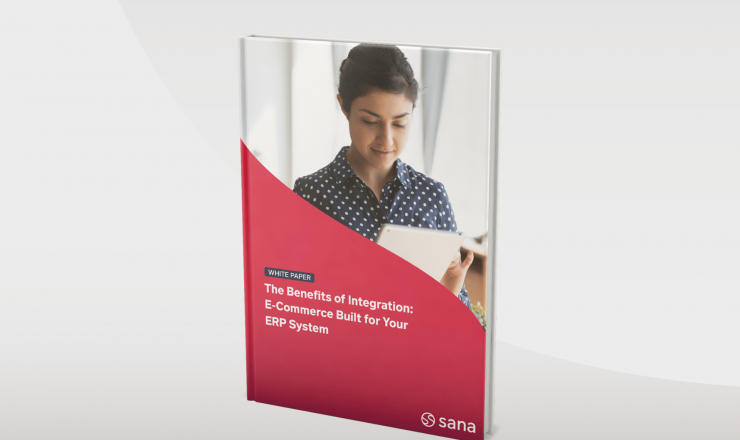

So, you’re moving ahead with a new ERP implementation. At the same time, you want to get your e-commerce platform set up as soon as possible.
You’re waiting for the ERP implementation so that you can shift your focus to your e-commerce project to start planning for the future of your business. The only downside is that your ERP implementation will take months before you’re up and running.
While a lot of IT or e-commerce managers think it’s better to wait with e-commerce until after implementing a new ERP, we disagree: Going live with your ERP implementation and e-commerce at the same time can benefit you more in the long run.
Speaking from experience, we’ve seen that if you are looking for an e-commerce solution provider that integrates with your ERP, it can save you time and money down the road when you go live with your web store at the same time as your new ERP.
While there are pros and cons to doing this, ultimately it all depends on the e-commerce software you choose.
Why should you go live with your ERP and e-commerce site at the same time?
Imagine it’s time to take your car to the garage for an inspection: Lately you’ve noticed your engine light has come on and your wheels are looking worn down. You plan to keep this car for a while — it was a big investment after all — and want a reliable vehicle.
Naturally, you want the best for your car and your family, so you have everything checked out at once. Or are you going to waste time and effort going to the garage on two separate occasions?
It’s just like having made the investment in an ERP implementation project. You know that you’re going to want to start or change your e-commerce site as soon as it’s done. So why push off or delay your e-commerce project? It’s the perfect time to combine.
Benefits of going live with your e-commerce and ERP at the same time
- Give your business a fresh start
- Get up-to-date functionalities for both your e-commerce and ERP
- Align ERP processes with that of your e-commerce site
- Optimize ERP infrastructure to make full use of your online store
- Create a new sales flow for employees
- Improve customer experience
1. Give your business a fresh start
A clean slate makes it easier to build a strategy that is structured and allows for clarity within an organization. Your business has a chance at a complete rebranding, but from both an inside (through the ERP) and from an outside perspective (your e-commerce site).
2. Get up-to-date functionalities for both your e-commerce and ERP
It can become difficult to keep up with buyers’ expectations and needs both through e-commerce as well as in terms of speed and efficiency. Customers’ lives become easier by having an updated e-commerce platform that includes key features like comprehensive search, personalized assortments, order tracking functionality, and online payment options. An ERP that can keep up with these features is necessary to make it work.
3. Align ERP processes with that of your e-commerce site
Many ERP processes are outdated. There must be alignment whether implementing a new ERP or a new e-commerce solution. A key benefit of doing so in parallel with each other is that it presents the opportunity for a business to digitize processes in alignment with one other. It allows for a business to step back and re-evaluate current ERP processes to decide on the most efficient way forward.
4. Optimize ERP infrastructure to make full use of your online store
Running the ERP and e-commerce implementation in parallel allows flexibility. A business is better able to optimize the set-up of the ERP in a way that makes full use of the e-commerce solution, and in a way that works for the business. If not done in parallel, an organization runs the risk of missing out on key elements that the intake process of the new ERP or e-commerce solution.
5. Create a new sales flow for employees
Your salespeople can make use of the e-commerce solution instead of the ERP which creates a better experience and reduces complications for both employees as well as customers. Providing your salespeople with a platform they can rely on, instead of needing to look in the backend (ERP) for basic functions.
6. Improve customer experience
Provide your customers with the online buying experience they expect can help you process orders faster, with more accuracy and with less reliance on offline customer support teams. It’s a win all around.
Downsides of going live with your ERP and e-commerce at the same time
Running an ERP implementation alongside the implementation of an e-commerce platform isn’t all sunshine and rainbows – some hurdles to consider include:
- Longer project run times
Gaps in data and incomplete business processes contribute to longer project run times. Or if you’ve opted for an ERP-integrated solution, you’ll need to make sure that your ERP work is complete and up-to-date in order to go live with your e-commerce, which can take some time to get sorted. - Unanticipated customizations in the ERP
Customizations of the ERP which were not captured in the initial requirements assessment can affect the way in which the e-commerce solution is built. If this is not captured early enough in the project stage, it might delay the process of the e-commerce implementation. - Chance of e-commerce data loss
When the ERP data is refreshed without a back-up, this can result in losing data. A simple way to overcome this to ensure the right safety nets and data backup and storage procedures are in place so that no important data gets lost in the process. - Shifts in priorities and a change of focus
As the length of an ERP implementation can take anywhere from a few months to a few years depending on your business complexity, priorities can shift during this time. It can therefore become unclear which project to focus on. Multiple stakeholders working on different projects within the same ERP environment can cause conflicts.
Teams that take ownership of e-commerce implementation and ERP implementation are different. To overcome this, it’s important to assign clear roles and project managers for each to ensure a smooth roll-out and transition.
Why is ERP integration important in B2B e-commerce?
Your ERP system is a complex. Depending on your industry, it could be where you manage business-critical logic and data concerning your ordering processes, accounting, supply chain management, procurement, and so much more.
With ERP e-commerce integration, your customers are kept in the loop during the entire sales process. Your inventory data remains organized, accurate, and reliable 100% of the time, from one single hub.
Integrating your ERP and e-commerce platform is a must if you want to:
- Save company time
- Simplify order tracking
- Automate tasks
- Handle increases in demand
- Scale your business
ERP integration in B2B e-commerce can help you take online sales to the next level without increasing your employee workload. There is a lot of data and logic stored in the ERP that you need to use if you want your web store to accurately reflect all your commercial processes. For future-proof growth, you need future-proof solutions – that’s where ERP-integrated e-commerce comes in.
Frequently asked questions
Why is digital transformation in e-commerce necessary?
If it’s not broken, don’t fix it – right? Most business leaders today don’t think so. Across all sectors, organizations have felt the impact of a pandemic, followed by political and socio-economic instabilities. An investment in digital transformation is also an investment into future-proofing your business. The more agile your strategy, the better your chances for sustaining growth through all kinds of disruption.
When to implement (or upgrade) your current ERP system?
Either you want to implement a new ERP system or are looking for a SaaS solution to modernize your current ERP platform. You want to make the change because the current one isn’t meeting the needs of your business. Implementing a new ERP system means improving efficiency and increasing productivity within your company by streamlining and automating processes. An ERP system will add many benefits for your business:
- Provide data visibility and ensure transparency and accessibility.
- Streamline business processes to eliminate the need for manual updating and order entry.
- Improve customer satisfaction by simply keeping their orders up to date.
- Increase ROI because although ERP systems are expensive to implement, there’s almost a guaranteed ROI where your ERP pays for itself.
In other words, you’re modernizing and setting up your business for success.
Can I integrate my ERP, PIM and online store?
The short answer is yes. And we 100% recommend doing so.
- Your ERP system contains and shares master data;
- Your PIM system creates categorized content that can be used for multiple distribution channels;
- Your integrated web store brings it all online so your customers can find and order what they need.
Together, you could say it’s the ultimate online sales triumvirate.
What are the benefits of an ERP-integrated e-commerce solution as opposed to using a mainstream solution?
With an ERP-integrated solution*, all changes to your ERP data appear immediately in your web store and vice versa. Our solution is built into your ERP and does not rely on third-party connectors or middleware.
Sana Commerce Cloud processes all your information in one place, eliminating redundancies, inconsistencies and the need to manually maintain more than one set of business data.
* We only integrate with Microsoft Dynamics & SAP ERPs.

Undergoing a Dynamics or SAP ERP implementation?
Want to go live with your e-commerce platform as well?



